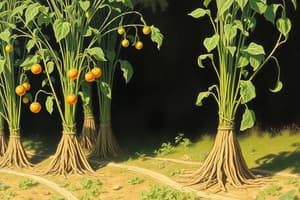Podcast
Questions and Answers
Match the following vegetables with their growth patterns:
Match the following vegetables with their growth patterns:
Zwiebeln = Unterirdisch in Form einer geschwollenen, unterirdischen Stängel Karotten = Unterirdisch von den Wurzeln der Pflanze Linsen = Überirdisch in Form von Blättern Blumenkohl = Überirdisch in Form von Stängeln
Match the following vegetables with their characteristics:
Match the following vegetables with their characteristics:
Wurzelgemüse = Reich an Stärke und Faser Blattgemüse = Reich an Vitaminen und Mineralien Knollengemüse = Wachsen unterirdisch in Form einer geschwollenen, unterirdischen Stängel Stängelgemüse = Wachsen überirdisch in Form von Stängeln
Match the following vegetables with their edible parts:
Match the following vegetables with their edible parts:
Zwiebeln = Die Blüten Karotten = Die Wurzeln Linsen = Die Blätter Blumenkohl = Die Stängel
Match the following vegetables with their cultivation methods:
Match the following vegetables with their cultivation methods:
Match the following vegetables with their nutritional value:
Match the following vegetables with their nutritional value:
Match the following vegetables with their classification:
Match the following vegetables with their classification:
Ordnen Sie die folgenden Gemüsearten ihren typischen Anbauorten zu:
Ordnen Sie die folgenden Gemüsearten ihren typischen Anbauorten zu:
Welche Anbaumethoden gibt es?
Welche Anbaumethoden gibt es?
Welche Nährstoffe sind in bestimmten Gemüsearten reich?
Welche Nährstoffe sind in bestimmten Gemüsearten reich?
Welche Vorteile bietet die Hydroponik?
Welche Vorteile bietet die Hydroponik?
Welche Herausforderungen gibt es bei der Gemüseproduktion?
Welche Herausforderungen gibt es bei der Gemüseproduktion?
Welche Vorteile bietet die Vertikale Landwirtschaft?
Welche Vorteile bietet die Vertikale Landwirtschaft?
Flashcards are hidden until you start studying
Study Notes
Gemüse: The Diverse World of Vegetables
Gemüse, or vegetables, is a broad category encompassing a wide range of plants with edible parts that are not classified as fruits. This includes various types of leaves, stems, roots, and even flowers, which are cultivated for their taste, nutritional value, and culinary potential. Vegetables are an essential part of a balanced diet, providing essential vitamins, minerals, and fiber.
Classification and Cultivation
Gemüse can be classified into several categories based on their type and characteristics. These include bulb vegetables, root vegetables, leafy greens, stem vegetables, and flower vegetables. Each type has its unique growth patterns and cultivation methods, reflecting the diverse nature of this food group.
Bulb Vegetables
Bulb vegetables, such as onions and garlic, grow underground in the form of a swollen, underground stem called a bulb. These plants are typically grown from a seed, and as they mature, the bulb develops, eventually being harvested for its edible contents.
Root Vegetables
Root vegetables, like carrots and potatoes, grow underground from the plant's roots. The edible part of the plant is the root itself, which is harvested and consumed. These vegetables are often rich in starch and fiber, providing a significant source of energy and nutrients.
Leafy Greens
Leafy greens, such as lettuce and spinach, are grown for their leaves, which are rich in vitamins and minerals. These plants are typically grown in fields, greenhouses, or hydroponically, and their leaves are harvested at various stages of maturity to ensure a continuous supply of fresh greens.
Stem Vegetables
Stem vegetables, like asparagus and artichokes, are grown for their edible stems. These plants require specific cultivation methods, such as pruning or selective harvesting, to ensure the stem remains tender and flavorful.
Flower Vegetables
Flower vegetables, like cauliflower and broccoli, are grown for their edible flower buds. These plants are cultivated to encourage the formation of these flower buds, which are harvested and consumed for their unique taste and texture.
Cultivation Methods
Vegetables can be grown using various cultivation methods, including traditional farming, hydroponics, and vertical farming. Each method has its advantages and disadvantages, influencing factors such as crop yield, water usage, and environmental impact.
Traditional Farming
Traditional farming involves planting seeds in soil and growing the plants with the help of water, sunlight, and nutrients from the soil. This method has been used for centuries and is still widely practiced today, particularly for many types of vegetables.
Hydroponics
Hydroponics involves growing plants in a nutrient-rich water solution, without the need for soil. This method offers several advantages, such as increased crop yield, faster growth rates, and reduced water usage. However, it requires a significant initial investment and specialized knowledge.
Vertical Farming
Vertical farming involves growing plants in stacked layers, often in controlled environments such as greenhouses. This method allows for increased crop yields in smaller spaces, reduced water usage, and the ability to grow crops year-round. However, it also requires significant infrastructure and energy inputs.
Health Benefits and Nutritional Value
Gemüse provides a wide range of health benefits, with many vegetables being rich in essential vitamins, minerals, and fiber. For example, leafy greens like spinach are high in iron, while root vegetables like carrots are rich in vitamin A. Eating a diverse range of vegetables can help ensure a balanced diet and support overall health.
Challenges and Future Developments
Despite the numerous benefits of Gemüse, there are also challenges associated with its cultivation, such as environmental impact, food security, and market fluctuations. To address these challenges, researchers and farmers are exploring new technologies, such as hydroponics and vertical farming, to increase efficiency and sustainability in the production of vegetables.
In conclusion, Gemüse is a diverse and essential food group that offers a wide range of health benefits and culinary possibilities. Its cultivation methods continue to evolve, driven by the need for sustainable production and the desire to provide a consistent supply of fresh, nutritious vegetables.
Studying That Suits You
Use AI to generate personalized quizzes and flashcards to suit your learning preferences.




